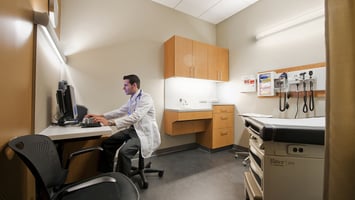According to NFPA 99, the Health Care Facilities Code, operating rooms are to be considered wet...
9 Considerations when Planning a Hybrid OR in an ASC
A hybrid operating room in the outpatient setting is equipped with fixed imaging equipment, such as a C-arm or biplane. While open surgery can be performed in these rooms, the imaging technology allows for advanced image-guided procedures across specialties like cardiology, neurosurgery, and spine. These rooms may also function as a cardiac catheterization lab, allowing the facility to operate as an Office-Based Lab (OBL) on certain days, enabling a broader range of cardiovascular services. Here are 9 important considerations when planning a hybrid operating room:
Regulatory Considerations
While the Centers for Medicare & Medicaid Services (CMS) has approved various cardiac procedures for ASCs, state regulations may vary. It is important to verify your state's laws regarding the performance of these procedures in surgery centers. Additionally, you must check if a Certificate of Need (CON) is required to offer these services in your state. See this post for additional regulatory requirements for an ASC.
Imaging Equipment Selection
Selecting the imaging equipment early in the design process is critical. As the most expensive component of the room, there may be a temptation to shop around; however, the room’s layout is designed around the specifics of this equipment. Each manufacturer's system has unique requirements and introducing the equipment too late in the design process may lead to redesign, costly change orders, or rework during construction.
Room Size and Layout
The operating room must be larger than standard ORs to accommodate the equipment and necessary clearances. Additional adjacent spaces, such as a control room and equipment storage, are also required. The design team—including clinicians, the architect, engineers, and equipment providers—should collaboratively develop the room's workflow. This includes placement of access points, cabinetry, controls and equipment to optimize functionality.
Structural Modifications for Floor and Ceiling Equipment
Floor-mounted C-arms and operating tables must be securely anchored to the underlying structure. In existing buildings, the slab on the ground floor will need to be cut for new footings, as well as for running power and data cables to the equipment. On upper levels, the floor structure will likely need reinforcement.
Ceiling-mounted C-arms, monitors, lead shields, and specialty lighting are installed on tracks above the operating table. The tracks are mounted to a structural grid above the ceiling and together with the HVAC ductwork and other services above the ceiling, extra space is usually required. It is important to plan in advance for the additional headroom.
Power and Medical Gas Provisions
One challenge with ceiling-mounted equipment is providing medical gas and electrical power drops near the operating table without creating obstructions. While costly, equipment booms, which can swivel out of the way, can provide these services while preventing hoses and cables from cluttering the floor space.
Airflow and Lighting Coordination
Careful coordination of the ceiling-mounted equipment with the laminar flow diffuser array—required over the OR table—is necessary. The laminar flow system, along with general room lighting, must be carefully planned around the ceiling tracks, equipment, and structural supports to ensure proper lighting and ventilation without interference. For these reasons and those in the two points above, a prefabricated ceiling solution can be a good option for these rooms.
Radiation Protection
To minimize radiation exposure from the C-arms used in the hybrid OR, lead shielding is typically required in the walls and doors, along with leaded glass in viewing windows. A radiation physicist should perform an analysis to determine the thickness and placement of lead required. This post on radiation shielding in an outpatient OR provides related information.
Electrical Requirements
The imaging equipment used in hybrid ORs generally demands more electrical power than standard OR equipment. These power requirements, which may vary based on the selected equipment, should be planned early in the design phase to ensure adequate capacity.
Equipment Delivery Logistics
During the planning process, ensure there is a clear route for delivering large imaging equipment from the building’s entry point all the way to the OR. This includes checking that doorways and hallways are wide enough to accommodate the equipment.
Designing a hybrid operating room in an ASC requires detailed planning and coordination. From regulatory requirements to equipment selection, room layout, and structural considerations, every decision will impact the functionality and success of the room. It’s always beneficial to work with an experienced architect and engineers to ensure a smooth design and construction process.
If you're planning a hybrid OR, Hardaway|Sziabowski Architects has extensive experience in designing these specialized spaces. Contact us for expert guidance and support!




